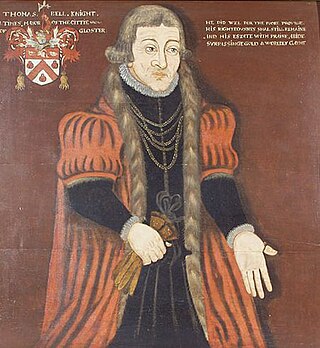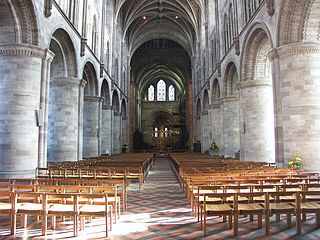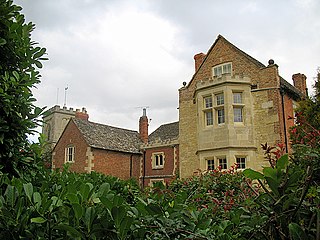Related Research Articles

Gloucester is a cathedral city and the county town of Gloucestershire in the South West of England. Gloucester lies on the River Severn, between the Cotswolds to the east and the Forest of Dean to the west, 19 miles (31 km) east of Monmouth and 17 miles (27 km) east of the border with Wales. Including suburban areas, Gloucester has a population of around 132,000. It is a port, linked via the Gloucester and Sharpness Canal to the Severn Estuary.

Anne of Gloucester, Countess of Stafford was the eldest daughter and eventually sole heiress of Thomas of Woodstock, 1st Duke of Gloucester, by his wife Eleanor de Bohun, one of the two daughters and co-heiresses of Humphrey de Bohun, 7th Earl of Hereford, 6th Earl of Essex (1341–1373) of Pleshey Castle in Essex.

Miles FitzWalter of Gloucester, 1st Earl of Hereford was a great magnate based in the west of England. He was hereditary Constable of England and Sheriff of Gloucestershire.


Sir Thomas Bell the Elder (1486–1566) was a cap manufacturer, mayor of Gloucester, and member of Parliament. He was one of the city's largest employers and wealthiest citizens and a great benefactor of the city and its people. He is described in contemporaneous documents as a "capper". He invested much of his wealth in real estate released on the Dissolution of the Monasteries, sometimes in partnership with Richard Duke, of Otterton, Devon, Clerk of the Court of Augmentations.

Llanthony Secunda Priory was a house of Augustinian canons in the parish of Hempsted, Gloucestershire, England, situated about 1/2 a mile south-west of Gloucester Castle in the City of Gloucester. It was founded in 1136 by Miles de Gloucester, 1st Earl of Hereford, a great magnate based in the west of England and the Welsh Marches, hereditary Constable of England and Sheriff of Gloucestershire, as a secondary house and refuge for the canons of Llanthony Priory in the Vale of Ewyas, within his Lordship of Brecknock in what is now Monmouthshire, Wales. The surviving remains of the Priory were designated as Grade I listed in 1952 and the wider site is a scheduled ancient monument. In 2013 the Llanthony Secunda Priory Trust received funds for restoration work which was completed in August 2018 when it re-opened to the public.

Robert de Bethune was a medieval bishop of Hereford. From a knightly family, he became a teacher before becoming a canon by 1115. He was elected prior of Llanthony Priory in the middle 1120s, and was named bishop by King Henry I of England in 1130. As bishop, he was often appointed a judge by the papacy, and was known for the care he took of his diocese.

Hempsted is a suburban village and former civil parish, on the edge of Gloucester in the county of Gloucestershire, England. The parish was abolished in 1966 and absorbed into the parish and city of Gloucester. In 1961 the parish had a population of 508.
Humphrey III de Bohun of Trowbridge Castle in Wiltshire and of Caldicot Castle in south-east Wales, 5th feudal baron of Trowbridge, was an Anglo-Norman nobleman and general who served King Henry II as Lord High Constable of England.

Leonard Stanley Priory was a priory in Gloucestershire, England. Over the years following the dissolution most of the buildings of the priory complex have been destroyed.
Kilpeck Priory was a Benedictine priory in Kilpeck, Herefordshire, England, at grid reference SO448303.
Arthur Porter was an English Member of Parliament (MP) and was granted Llanthony Secunda Priory. He was the only surviving son of Roger Porter of Newent and Alvington, Gloucestershire and was educated at Lincoln's Inn.
Sibyl de Neufmarché, Countess of Hereford, suo jure Lady of Brecknock, was a Cambro-Norman noblewoman, heiress to one of the most substantial fiefs in the Welsh Marches. The great-granddaughter of Gruffydd ap Llywelyn, king of Wales, Sibyl was also connected to the nobility of England and Normandy. Sibyl inherited the titles and lands of her father, Bernard de Neufmarché, Lord of Brecon, after her mother, Nest ferch Osbern, had declared her brother Mahel to have been illegitimate. Most of these estates passed to Sibyl's husband, Miles de Gloucester, 1st Earl of Hereford, as her dowry. Their marriage had been arranged personally by King Henry I of England in the spring of 1121. Sibyl, with her extensive lands, was central to the King's plans of consolidating Anglo-Norman power in south-east Wales by the merging of her estates with those of Miles, his loyal subject on whom he relied to implement Crown policy.
Margaret of Hereford was an English noblewoman and the eldest daughter of Miles de Gloucester, 1st Earl of Hereford by his wife, the wealthy Cambro-Norman heiress Sibyl de Neufmarché. Margaret married Humphrey II de Bohun, by whom she had five children. Margaret held the office of Constable of England and as a widow, exercised lordship of Herefordshire until her own death. She was the benefactress of several religious institutions.
Clement of Llanthony was an Anglo-Norman clergyman and theologian who became prior of Llanthony Priory. Clement became a canon at Llanthony at a young age, and was educated there. Having held the office of sub-prior, he became prior around 1150, and died sometime after 1167, although the year is not known.

Brockworth Court is a Tudor house in the village of Brockworth, Gloucestershire, England. It is a Grade II* listed building.

High Orchard was an industrial area of the city of Gloucester in England that was developed in the 19th century on the former orchard of the Priory of Llanthony Secunda (1136). The area was closely associated with Gloucester Docks immediately to the north, and served by the Gloucester and Sharpness Canal and railway transport. It was the site of Fielding & Platt's Atlas Works and a number of other significant local employers.

St Owen's Church was a church and parish within the City of Gloucester in Gloucestershire, England. The parish church of St Owen's was situated on Southgate Street, just outside the South Gate of the formerly walled city, and was founded before 1100, but was demolished by the City Corporation in 1643, during the Civil War in advance of the Siege of Gloucester.

Durand of Gloucester was Sheriff of Gloucestershire in 1086 and was one of the tenants-in-chief of King William the Conqueror in Gloucestershire and elsewhere, with a total of 63 holding listed in the Domesday Book of 1086.
References
- ↑ Walker, David. (ed.) Charters of the Earldom of Hereford 1095–1201. (2009) No. 11, (in Latin): General confirmation by Roger E. of Hereford to Llanthony Secunda (1143–55) of the chapel of St Kyneburg and all the land in its parish below the gate of "Suth/Sut" (South Gate?)
- ↑ 'Gloucester: Churches and chapels', in A History of the County of Gloucester: Volume 4, the City of Gloucester, ed. N M Herbert (London, 1988), pp. 292-311
- ↑ Gloucestershire Record Series vol. 15 'A Calendar Of The Registers Of The Priory of Llanthony by Gloucester 1457-1466, 1501-1525, ed. John Rhodes (pub. Bristol and Gloucestershire Archaeological Society, 2002), entry 35, pp. 20